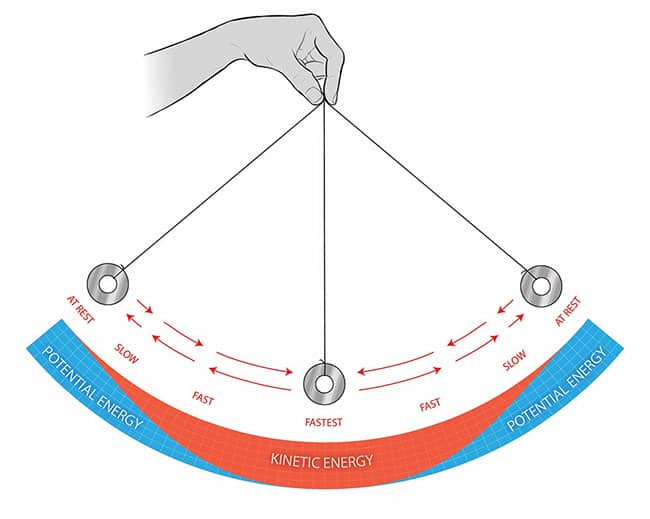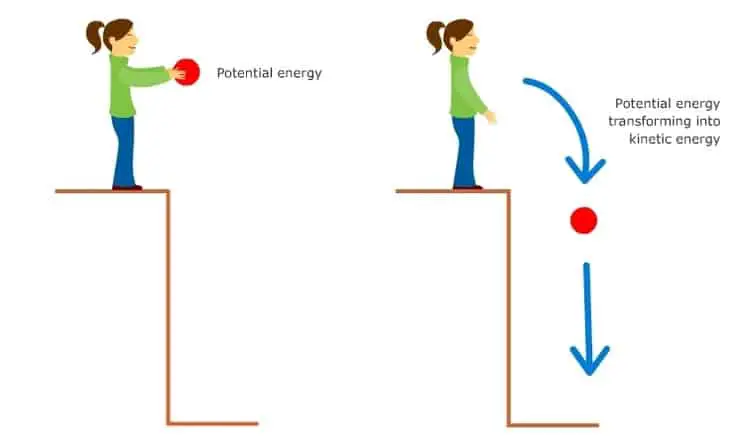There are many forms of energy that exist in nature. But, they all fall into two basic categories. These are kinetic and potential energy. And, when you combine them, what you get is mechanical energy. In other words, by definition, mechanical energy is the sum of kinetic and potential energy.
In this exclusive article, we will talk about the different types of mechanical energy and their real-life examples. What is the energy of motion? What is the energy of position? How to calculate mechanical energy?
More importantly, what is the conservation of mechanical energy? Or, what are the sources of mechanical energy? Not to mention, we will also talk about some of the exclusive facts about mechanical energy. Therefore, I would suggest you stick with me till the end. Let’s dive right in!!!
Mechanical Energy Facts
Did you know that an object can have both potential energy (due to its position) and kinetic energy (due to its motion) only and only in the case of the macroscopic world i.e Classical Physics, not in the microscopic world i.e Quantum Physics?
If an object can have both position (potential energy) and momentum (kinetic energy) in the quantum realm. It would directly violate the Heisenberg Uncertainty Principle.
Not to mention, there are some cases such as Quantum Entanglement where Heisenberg Uncertainty Principle does get violated. To know more about it, check out The EPR Paradox – A Thought, Myth, or, a Reality?
Mechanical Energy Simple Definition in Physics
By definition, mechanical energy is the sum of the kinetic and potential energy of a system. Not to mention, one can also define the ability to do work or cause change as mechanical energy.
When I say the energy of motion, I am strictly referring to the kinetic energy of the system. Similarly, when I say the energy of position, I am strictly referring to the potential energy of the system.
On the other hand, when I say the energy of a system or an object due to its motion as well as its position, I am strictly referring to the mechanical energy of the system i.e nothing but the sum of kinetic and potential energy.
Take a look at the Difference Between Nuclear Fission and Nuclear Fusion in Tabular Form
Conservation of Mechanical Energy
According to the law of conservation of mechanical energy definition, “energy can neither be created nor be destroyed, until or unless some kind of external forces like frictional forces or non-conservative forces is applied”.
In other words, the total mechanical energy of a system is conserved. Therefore, energy can only convert from one form to another form of energy.
YEAH YEAH, you would be thinking that the above-mentioned definition is of the law of conservation of energy i.e the first law of thermodynamics.
The author of the article must be lying and all. Well, let me clear the air. Neither I am lying, nor you are wrong. In fact, we both are correct. Confused????
Okay, let’s take an example to understand it properly. Not to mention, there can be so many examples to explain the concept of the conservation of mechanical energy. Out of all, I am going to explain the most generic one. Keep reading!!!
Take a look at What is Nuclear Energy? – Definition, Facts, Types & Examples
Physics of Pendulum

We all are well aware of the fact that what a pendulum is and what it does i.e swings back and forth!!! But, what we don’t know is how it works. More importantly, what’s the physics behind the working of a simple pendulum?
Well, the physics of the pendulum is solely based on the conservation of mechanical energy. For starters, a pendulum is a mechanical system that works due to the continuous exchange of kinetic and potential energy.
To make it more simple, let me bifurcate the physics of the pendulum into two cases. To put it differently, let me bifurcate the working of the pendulum into two specific positions.
Case 1 – Rest or Extreme Position
At an extreme position or at rest, the bob of the pendulum is at its maximum height. Therefore, as a result, it has the maximum potential energy and lowest kinetic energy.
WHY? Because at this point, on one hand, the bob has zero speed (zero kinetic energy). And, on the other hand, it is farthest away from the Earth’s gravitational well (maximum potential energy). See the above diagram for a proper understanding.
Case 2 – Vertical or Mean Position
Now let the bob free to swing back and forth. Therefore, when the bob reaches the vertical or mean position i.e its lowest height, it has the maximum kinetic energy and lowest potential energy.
WHY? Because at this point, on one hand, the bob has the maximum speed (maximum kinetic energy). And, on the other hand, it is nearest to the Earth’s gravitational well (zero potential energy). See the above diagram for a proper understanding.
Check Out: Difference Between Uniform and Non-uniform Motion with Examples
Therefore, by moving back and forth, the mechanical system of the simple pendulum has both kinetic and potential energy which is constantly changing between the two. Hence the mechanical energy of the system is conserved i.e constant.
Not to mention, in the above example, we are neglecting the effects of external forces like drag forces and frictional forces.
Mechanical Energy Facts
Did you know that it was English physicist James Prescott Joule who at first experimentally demonstrated that due to friction a certain amount of mechanical energy could be lost as thermal energy (heat)?
In fact, he also successfully demonstrated that even if the mechanical energy of a system (a simple pendulum) is lost as heat. But the overall or total energy of the system always remains constant.
Types of Mechanical Energy

Now, we have already talked a lot about kinetic energy and potential energy. But, as a matter of fact, we don’t know what they are!! Or, like how do they work? Therefore, without wasting any more time, let me give you a brief review of both of them.
Editor’s Choice: Top 6 Uniform Motion Examples in SIX minutes (All NEW)
By definition, mechanical energy can be bifurcated into two parts. Or, one can say that there are two types of mechanical energy i.e kinetic and potential energy.
Technically speaking, they are not the type or forms of mechanical energy. In fact, they are just the constituent of mechanical energy. Anyhow, let’s move ahead!!!
Kinetic Energy – Mechanical Energy of Motion
According to the definition of kinetic energy, when an object is in momentum (motion), it has energy in the form of kinetic energy. In other words, the energy of motion is called kinetic energy.
Check out: What is Kinetic Energy? – Definition, Types & Examples
Types of Kinetic Energy
Based on the type of motion, we can bifurcate kinetic energy into three primary sections. Not to mention, there are also some other ways to define the types of kinetic energy. However, in this article, I am only explaining it in contrast to the type of motion.
- Translational Kinetic Energy – due to the straight-line motion of a body
- Rotational Kinetic Energy – due to the rotational motion of a body
- Vibrational Kinetic Energy – due to the vibrational motion of a body
Potential Energy – Mechanical Energy of position
The energy that is stored in an object due to its position is known as potential energy. In other words, the energy that is stored is called potential energy. Well, I would rather say not just because of its position, there are some other factors too.
In general, one can say that it’s the energy held by an object not only because of its position relative to other objects. But also because of the stresses within itself, its electric charge, or some other factors.
In fact, based on these factors that affect the potential energy of an object, it can be further dissected into several parts.
Must read: What is Potential Energy? – Definition, Facts, Types & Examples
Types of Potential Energy
There are so many types of potential energy such as:
- Gravitational Potential Energy
- Magnetic Potential Energy
- Electric Potential Energy
- Elastic Potential Energy
- Nuclear Potential energy
- Chemical Potential Energy, etc.
Total Mechanical Energy Formula
How to calculate the mechanical energy of a system? Well, it’s quite simple and straightforward. I mean just add the kinetic and potential energy of a system. After that, what you get is the total mechanical energy.
Related: Difference Between Kinetic and Potential Energy in Tabular Form
According to the definition of mechanical energy, the sum of the kinetic and potential energy is the total mechanical energy of a system. Let’s see how!!!
Total mechanical energy = Kinetic Energy + Potential Energy
TME = KE +PE
Where,
Kinetic Energy = ½mv²
Potential Energy = mgh
putting the value of kinetic and potential energy in the total mechanical energy formula, we get:
TME = ½mv² + mgh
Mechanical Energy Facts
Did you know that the word mechanical energy only corresponds to Newtonian mechanics i.e macroscopic world?
In the microscopic world i.e quantum mechanics, the word mechanical energy of a system is replaced with hamiltonian of a system.
In other words, in the quantum mechanical world, the hamiltonian of a system is equal to the sum of the kinetic and potential energy of a system.
Mechanical Energy Examples in Everyday Life

If you think you can’t relate to mechanical energy examples in everyday life. Well, here is your chance to think again!
- Hammer
- Gun
- Windmill
- wrecking ball
- Bowling ball
- A cyclist
- water behind dam
- Earth-moon system
- Simple pendulum, etc.
Sources of Mechanical Energy

As you already know that by definition, mechanical energy is nothing but energy in conversion. In other words, there are many devices that are basically used to convert mechanical energy into other forms of energy or vice versa.
These types of devices are basically defined as different sources of mechanical energy. Some of them are listed below!!!
- An internal combustion engine converts the chemical energy of fuel into mechanical energy.
- An electric motor converts electrical energy into mechanical energy.
- The hydropower plant converts the mechanical (potential) energy of water into electrical energy.
- A steam engine converts the heat energy of steam into mechanical energy, etc.
That’s it for this post. If you like this article, share it if you like, like it if you share it. You can also find us on Mix, Twitter, Pinterest, and Facebook. Hey man, If you have come this far, do give us feedback in the comment section. It would make my day. You can also make a donation. Your donations will help us to run our website and serve you BETTER. Cheers!!!
You might also like:
- Top 6 Different Types of Energy with Their Examples (All New)
- Petrol Engine vs Diesel Engine (Tabular Form)
- Top 6 Non-uniform Motion Examples in SIX Minutes
- Renewable Resources: Definition, Examples, Advantages, Disadvantages & its Future
- Nonrenewable Resources: Definition, Examples, Advantages, Disadvantages
Thank you, I have just been looking for information approximately this subject for a while and yours is the greatest I’ve found out till now.
thank you. Keep visiting us!!!
Hello, after reading this amazing article, I am too happy to share my familiarity here with mates.
Hello Leslie, Thanx, keep visiting us!!!